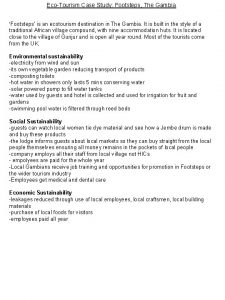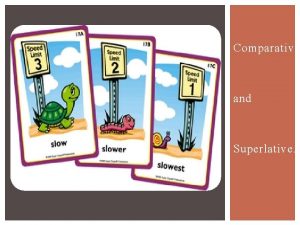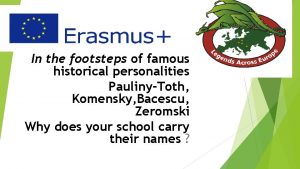In Thoreaus Footsteps A Comparative and Historical Survey

















- Slides: 17

In Thoreau’s Footsteps: A Comparative and Historical Survey of Plant Taxa on the Summit of Mount Monadnock (Fall 2006) as Guided by Henry David Thoreau’s Journal Account of Summit and Southwestern Slope Vegetation Observed (August 1860) Dianne Eno (ES 702 A Comparative Ecological Analysis)

Thoreau’s Campsite of August-1860 “A sunken yard” on the southwestern slope of Mount Monadnock The purpose of this study – • to search for and identify the seventy-six (76) plant taxa, as observed and noted by Henry David Thoreau on his summer 1860 excursion to Mt. Monadnock. • as an historical retracing of Thoreau’s pathway up the south western slope of the mountain, with special focus given to the forested areas immediately below tree-line in this area, and his campsite. • • to use Thoreau’s descriptive journal record as a guide in the search for the presence of single representatives of each plant.

HDT’s list (excerpt from his journal entry Aug. 9, 1860) “I observed these [76 species] plants on the rocky summit of the mountain [Monadnock], above the forest”: • Raspberry, not common. • Low blueberries of two or three varieties. • Bunchberry. • Solidago thyrsoidea [large mountain golden rod] • Fetid currant, common; leaves beginning to be scarlet; grows amid loose fallen rocks. • Red cherry, some ripe, and handsome. • Black choke-berry. • Potentilla tridentate, still lingering in bloom. • Aralia hispida, still lingering in bloom. • Cow-wheat, common, still in bloom. • Mountain cranberry, not generally abundant; full grown earlier than lowland ditto. • Black spruce. • Lambkill, lingering in flower in cool and moist places. • Aster acuminatus, abundant; not generally open, but fairly begun to bloom. • Red elder, ripe, apparently in prime, not uncommon. • Arenaria Groenlandica, still pretty common in flower. • Solidago lanceolata, not uncommon; just fairly begun. • Epilobium angustifoliumi, in bloom; not common, however. • Epilobium palustre, some time, common in mosses, small and slender. • Wild holly, common; berries not quite ripe.

Viburnum nudum, common; berries green. White pine; saw three or four only, mostly very small. Mountain-ash, abundant; berries not ripe; generally very small, largest in swamps. Diervilla, not uncommon, still. Rhodora, abundant; low, i. e. short. Meadow-sweet, abundant, apparently in prime. Hemlocks; two little ones with rounded tops. Chelone glabra, not yet; at northeast swamp-side. Yarrow. Canoe birch, very small. Clintonia borealis, with fruit. Checkerberry. Gold-thread. One three-ribbed goldenrod, northwest side (not Canadense). Tall, rough goldenrod, not yet; not uncommon. Populus tremuliformis, not very common. Populus cilinode, in bloom. Yellow birch, small. Fir, a little; four or five trees noticed. Willows, not uncommon, four or five feet high. Red maple, a very little, small. Water andromeda, common about the bogs. [Bog rosemary] Trientalis. Pearly everlasting, out.

Diplopappus umbellatus, in bloom, not common (? ); northeast swamp-side, also northwest side of mountain. Juncus trifidis. Some Juncus paradoxus? Some Juncus acuminatus? }about edges of marshes. CYPERACEAE Eriophorum gracile, abundant, whitening the little swamps. Eriophorum vaginatum, abundant, little swamps, long done, (this the coarse grass in tufts, in marshes). Wool-grass, not uncommon, (common kind). Carex trisperma (? ) or Dewyana, with large seeds, slender and drooping, by side of northeast swamp. Vide press. Carex scoparia? Or straminea? a little. C. debilis. Carex, small, rather close-spiked, C. canescens-like (? ), common. GRASSES Aira flexuosa. Glyceria elongate, with appressed branches (some purplish), in swamp. Blue-joint, apparently in prime, one place. Festuca ovina, one place. Cinna arundinacea, one place. Agrostis scabra (? ), at our spring, q. v.

FERNS AND LICHENS, ETC. A large greenish lichen flat on rocks, of a peculiar concentric growth, q. v. Some common sulphur lichen. The very bright handsome crustaceous yellow lichen, as on White Mts. , q. v. Two or three umbilicaria lichens, q. v. , giving the dark brown to the rocks. A little, in one place, of the old hat umbilicaria, as at Flint’s Pond Rock. Green moss and sphagnum in the marshes. Two common cladonias, white and greenish. Stereocaulon. Lycopodium complanatum, one place. Lycopodium annotinum, not very common Common polypody. Dicksonia fern, q. v. Sensitive fern, and various other common ones. Reference— Howarth, W. (2001). Walking with Thoreau: a literary guide to the mountains of New England. Boston: Beacon Press.

Field data collected: • “Present” (P) or “not present” (NP) (whether, or not the plant was found on the mountain and identified). • Approximate location: “Historic” (indicates taxa found in original location, approximated/ estimated by a combination of data “evidence”/ clues); “Other” (taxa found and identified, but in a different location from historic accounts/ clues); or both categories apply. • “Commonness” factor: 1 (Abundant); 2 (Common); 3 (Uncommon); 4 (Rare); or 5 (Not observed). • Approximate altitudinal zones: 4 -zone categories established by forester, H. Baldwin, as a way to map an estimation of plant taxa distribution on the southwestern slope of the mountain (Baldwin, 1977).

The route taken on each of 3 days in the field in search of Thoreau’s plant taxa (Fall-2006) • Paradise Valley Trail • Summit Area • Thoreau’s campsite (1860)

Monadnock: a key wetland area • Of the seventy-six original plant taxa listed in Thoreau’s journal, a majority (69. 74%) have Region 1 Wetland Indicator Status.

Key for Map




A pattern revealed…. . Zone 3…Of critical importance to Mt. Monadnock’s ecological health? A breakdown of taxa types in each altitudinal zone revealed the following pattern: • Trees are most dominant in Zone 2; • Woody shrubs, Zone 3; • Herbs, Zone 3; • Grasses, Zone 4; • Ferns and Mosses, Zones 3 and 4, equally; • Sedges, Zones 3 and 4, with a predominance in Zone 4; • Lichens, Zones 3 and 4, equally.



Some conclusions… • 96. 05% of Thoreau’s plants were found to be alive and well on Monadnock, nearly 150 years after his 1860 excursion to the mountain! • Zone 3 exhibits a particular abundance of plant life and rich diversity—this was most clearly observed. • Of Thoreau’s plants that were identified, 65. 79% (50 out of 76) were found in Zone 3. • Zone 3 is acting as a buffer zone, counteracting to some degree the decimating effects of heavy hiker traffic, especially at the exposed rocky summit. “They who simply climb to the peak of Monadnock have seen but little of the mountain. I came not to look off from it, but to look at it. ” Henry David Thoreau
 In the footsteps of jesus andrew chinn
In the footsteps of jesus andrew chinn Primary survey secondary survey
Primary survey secondary survey Superlative de tall
Superlative de tall Concept and scope of comparative education
Concept and scope of comparative education Correlational and comparative research
Correlational and comparative research Romeo and juliet historical context
Romeo and juliet historical context Pride and prejudice historical context
Pride and prejudice historical context History of midwifery in india ppt
History of midwifery in india ppt Factors influencing contemporary nursing practice
Factors influencing contemporary nursing practice 5-5 linear automobile depreciation answers
5-5 linear automobile depreciation answers Historical and biographical approach
Historical and biographical approach Jekyll and hyde historical context
Jekyll and hyde historical context Historical background of mice and men
Historical background of mice and men Historical concepts and skills
Historical concepts and skills Romeo and juliet as a tragedy
Romeo and juliet as a tragedy Russian formalism literary theory
Russian formalism literary theory Major historical perspective of nursing and computer
Major historical perspective of nursing and computer Sir gawain medieval romance
Sir gawain medieval romance

































